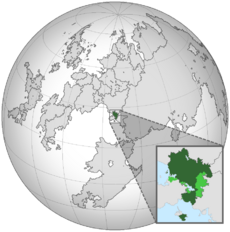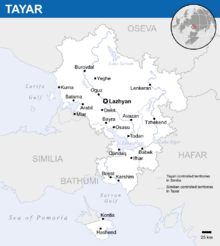Tayar: Difference between revisions
No edit summary |
|||
| Line 94: | Line 94: | ||
The [[Tayar#Government and politics|National Council]], having 186 seats in total, is the country's {{wp|unicameral}} {{wp|legislature}}. Membership in the National Council is based off the {{wp|proportional representation}} of the {{wp|political party|political parties}}, which, with an electoral threshold of 6%, resultes in the formation of coalition governments between two or more parties. Parliamentary {{wp|democracy|elections}} are scheduled to be held every five years, but the unstable appearance of a sitting government or a {{wp|motion of no-confidence|vote of no-confidence}} by the Parliament can cause it to dissolve the government earlier. | The [[Tayar#Government and politics|National Council]], having 186 seats in total, is the country's {{wp|unicameral}} {{wp|legislature}}. Membership in the National Council is based off the {{wp|proportional representation}} of the {{wp|political party|political parties}}, which, with an electoral threshold of 6%, resultes in the formation of coalition governments between two or more parties. Parliamentary {{wp|democracy|elections}} are scheduled to be held every five years, but the unstable appearance of a sitting government or a {{wp|motion of no-confidence|vote of no-confidence}} by the Parliament can cause it to dissolve the government earlier. | ||
The Tayari Constitution functions as a formal {{wp|uncodified constitution}} despite its name. | The Tayari Constitution functions as a formal {{wp|uncodified constitution}} despite its name. | ||
Though Tayar does not mention or exlude a religion as official, political ideologies and historical actions at hand resemble a close connection to X, having caused a continuous debate about the separation of state law and religious law. Interaction between political and religious acteurs maintains an ideological balance and has been the basis of a stable governmental system since Tayar's foundation. | Though Tayar does not mention or exlude a religion as official, political ideologies and historical actions at hand resemble a close connection to X, having caused a continuous debate about the separation of state law and religious law. Interaction between political and religious acteurs maintains an ideological balance and has been the basis of a stable governmental system since Tayar's foundation. | ||
Residents in Tayari controlled territories of Hilmania, the West Settlement, are eligible to vote and decide in political affairs since 2013. This decision by the Constitutional Court has led to a political and populous outcry and has raised questions as well as criticism about the behaviour of the Tayari government. | |||
| Line 109: | Line 109: | ||
===Foreign relations=== | ===Foreign relations=== | ||
===Military=== | ===Military=== | ||
==Economy== | ==Economy== | ||
==Demographics== | ==Demographics== | ||
Revision as of 17:44, 12 March 2020
This article is incomplete because it is pending further input from participants, or it is a work-in-progress by one author. Please comment on this article's talk page to share your input, comments and questions. Note: To contribute to this article, you may need to seek help from the author(s) of this page. |
Tayari Republic Gomhûrî Tayârê (Tayari) | |
|---|---|
| Motto: "X" "For Our People" | |
| Anthem: "X" "Banner of the Fatherland" | |
 Location of Tayar (green) with Similian and foreign Tayari controlled territories (light green) | |
 19XX border (internationally recognized) | |
| Capital and largest city | Lazhyan |
| Official languages | Tayari |
| Recognised regional languages | Lavish, Osevan |
| Ethnic groups | X |
| Religion | X |
| Demonym(s) | Tayari |
| Government | Unitary semi-presidential republic |
• President | Mahmoud Wezwar |
• Minister-General | Bushar Aboun |
• Speaker of Parliament | Salim Leuge |
| Legislature | National Council |
| Formation | |
• X | X |
• X | X |
• X | X |
• X | X |
• X | X |
• X | X |
• X | X |
| Area | |
• Total | 37,749 km2 (14,575 sq mi) |
• Water (%) | 4.8% |
| Population | |
• 2018 estimate | 9,735,800 |
• 2017 census | 9,416,393 |
| GDP (PPP) | 2019 estimate |
• Total | $165.4 billion (16th) |
• Per capita | $16,992 |
| GDP (nominal) | 2018 estimate |
• Total | $71.6 billion (17th) |
• Per capita | $7,350 |
| HDI (2017) | 0.753 high |
| Currency | Herai (२) (HR) |
| Time zone | UTC+4 |
| Date format | MM/DD/YYYY |
| Driving side | right |
| Calling code | +838 |
| Internet TLD | .ty |
Tayar (/təˌjɑː(ɹ)/; Tayari: Tayâr [tɑˈjɑːr]), officially the Tayari Republic (Tayari: Gomhûrî Tayârê [gɔmhuːriː tɑˈjɑːrɛː]), is a country at the crossroads of Pomria and Daria. Located in western Daria, it is bounded by Oseva to the north, the Larija Gulf to the west, Similia to the south-west, the Sarvan Gulf to the south, and Hafar to the east. Tayar is a unitary nation-state and multi-party democracy with an ancient cultural and historical heritage. It has a population of around 9.4 million as of 2017 and an area of 37,749 km2 (14,575 sq mi), though its territorial integrity has only partial recognition. Its capital and largest city is Lazhyan.
Tayar is a unitary semi-presidential republic as definded by its constitution with a parliamentary system, proportional representation, and universal suffrage since 1940. The President serves as head of state and de facto leader of the country, though only ceremonial, while in reality the Minister-General oversees political affairs as head of government. The National Council is the country's unicameral legislature. Tayar maintains diplomatic relations with two-thirds of the world's countries and holds membership in a number of international organizations, including the Assembly of Nations (since 1967), X. It has a high level of human development as indicated by the Human Development Index. It has a reasonable rate of economic development, as it is the 16th or 17th-largest economy in the world, high rate of literacy, women's safety, employment, and ranks among the world's top nations by percentage of citizens with military training. However, the government has been criticized for its treatment and harrassment of ethnic Similian in disputed territories and human rights abuses.
Etymology
History
Antiquity
X
X2
X3
Geography and environment
Government and politics
Tayar is a unitary semi-presidential republic as definded by its constitution with a parliamentary system, proportional representation, and universal suffrage since 1940. The President serves as head of state and de facto leader of the country, though only ceremonial, while in reality the Minister-General oversees political affairs as head of government. The Minister-General is a member of parliament supported by a parliamentary majority.
The National Council, having 186 seats in total, is the country's unicameral legislature. Membership in the National Council is based off the proportional representation of the political parties, which, with an electoral threshold of 6%, resultes in the formation of coalition governments between two or more parties. Parliamentary elections are scheduled to be held every five years, but the unstable appearance of a sitting government or a vote of no-confidence by the Parliament can cause it to dissolve the government earlier.
The Tayari Constitution functions as a formal uncodified constitution despite its name.
Though Tayar does not mention or exlude a religion as official, political ideologies and historical actions at hand resemble a close connection to X, having caused a continuous debate about the separation of state law and religious law. Interaction between political and religious acteurs maintains an ideological balance and has been the basis of a stable governmental system since Tayar's foundation.
Residents in Tayari controlled territories of Hilmania, the West Settlement, are eligible to vote and decide in political affairs since 2013. This decision by the Constitutional Court has led to a political and populous outcry and has raised questions as well as criticism about the behaviour of the Tayari government.

